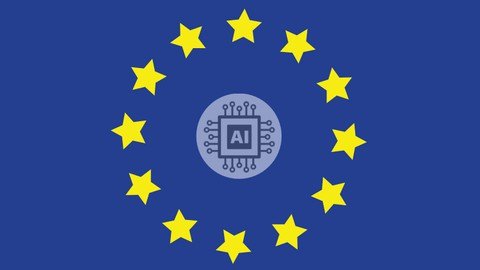European Union Artificial Intelligence Act

Published 4/2024
MP4 | Video: h264, 1920x1080 | Audio: AAC, 44.1 KHz
Language: English | Size: 971.52 MB | Duration: 2h 24m
A thorough walkthrough of the new EU AI regulation and requirements for taking high risk AI systems to market in EU
What you'll learn
Introduction and Purpose of the new AI regulation
Understand all the chapters of EU Artificial Intelligence Act including Prohibited AI practices and High Risk AI systems
Governance Requirements for High Risk AI systems
Conformity Assessment Procedure for key High Risk AI systems
Transparency Requirements and General Purpose AI models
Requirements
No programming experience or skill is required
A basic understanding of Artificial Intelligence is recommended
A basic understanding of Artificial Intelligence Model Lifecycle is recommended
Description
In March 2024, The European Parliament approved the Artificial Intelligence Act to govern the use of AI in the European market.With the recent advances in Machine Learning & Artificial Intelligence and the introduction of generative AI like GPT-4 and DALL·E, government and regulatory bodies around the world are showing tremendous interest in strengthening existing regulations or introducing new ones. The EU AI act was first proposed in April 2021. On 14 June 2023, MEPs adopted Parliaments negotiating position on the AI Act and talks began with EU countries in the Council on the final form of the law. On 9th December 2023 MEPs reached a political deal with the Council on the Act. On 6th March, 2024 the regulation was endorsed by MEPs with 523 votes in favour, 46 against and 49 abstentions. This will go through a final lawyer-linguist check and will need to be formally endorsed by the Council before its publication in the official Journal (expected before June 2024).It will enter into force twenty days after its publication in the official Journal, and be fully applicable 24 months after its entry into force, except for: bans on prohibited practices, which will apply six months after the entry into force date; codes of practice (nine months after entry into force); general-purpose AI rules including governance (12 months after entry into force); and obligations for high-risk systems (36 months).What this course is - A thorough chapter wise walkthrough of the EU AI Act to help you grasp its tenets.What this course is not - Analysis or implementation of the Act. At this point, the information in the Act is at a very high level and the European Commission and the AI Office will release further information like common standards, templates, clarified definitions with example and other such information closer to the time when this Act becomes applicable. The course content is based on the pre-final version (released to public in March 2024) which can be downloaded in Section 1. The core tenets of the act are finalized and only changes expected at this stage are linguistic. Significant changes if any will be updated in the course.As of March 2024, the proposed penalties for non-compliance are as below:35 million EUR or 7% of worldwide revenue in past financial year (whichever is higher) for non-compliance with prohibited AI practices in Article 5 15 million EUR or 3% of worldwide revenue in past financial year (whichever is higher) for non-compliance with any other regulation in the Act (other than Article 5)7.5 million EUR or 1% of worldwide revenue in past financial year (whichever is higher) for supplying incorrect, incomplete or misleading information to notified bodies or national authorities15 million EUR or 3% of worldwide revenue in past financial year (whichever is higher) for general purpose AI models when the Commission finds that the provider intentionally or negligently:What is covered in this course?Section 1Course IntroductionIntroduction and Purpose of the ActSection 2 Chapter 1: General Provisions (Scope & Definitions)Chapter 2: Prohibited AI practicesSection 3 Chapter 3 Section 1: Classification of AI systems as High RiskChapter 3 Section 2: Requirements for High Risk AI systemsChapter 3 Section 3: Obligations of providers and deployers of High-Risk AI systems and other partiesChapter 3 Section 4: Notifying authorities and notified bodiesChapter 3 Section 5: Standards, Conformity Assessment, Certificates, RegistrationSection 4 Chapter 4: Transparency Obligations for Providers and Deployers of certain AI SystemsChapter 5: General Purpose AI ModelsSection 1: Classification rules Section 2: Obligations for providers of general-purpose AI modelsSection 3: Obligations for providers of general-purpose AI models with systemic riskChapter 6: Measures in Support of InnovationSection 5 Chapter 7: Governance Section 1: Governance at Union levelSection 2: National competent authoritiesChapter 8: EU Database for High-Risk AI SystemsChapter 9: Post-market Monitoring, Information Sharing, Market SurveillanceSection 1: Post-market monitoringSection 2: Sharing of information on serious incidentsSection 3: EnforcementSection 4: RemediesSection 5: Supervision, investigation, enforcement and monitoring in respect of providers of general-purpose AI modelsSection 6 Chapter 10: Codes of Conduct and GuidelinesChapter 11: Delegation of Power and Committee ProcedureChapter 12: PenaltiesChapter 13: Final ProvisionsEnroll now to develop a thorough understanding of European Union Artificial intelligence Act and the regulatory requirements for taking AI systems to market in the EU! Disclaimer: This course is only intended to serve as training material to aid in understanding of the EU AI Act and not as a legal interpretation of the Act. The instructor cannot be held responsible for any interpretation, judgement or view expressed in the course.
Overview
Section 1: Introduction
Lecture 1 Course Introduction
Lecture 2 Introduction and Purpose of the Act
Section 2: Chapters 1: General Provisions, 2: Prohibited AI practices
Lecture 3 Chapter 1: General Provisions (Scope & Definitions)
Lecture 4 Chapter 2: Prohibited AI practices
Section 3: Chapter 3: High Risk AI Systems
Lecture 5 Section 1: Classification of AI systems as High Risk
Lecture 6 Section 2: Requirements for High Risk AI systems
Lecture 7 Section 3: Obligations of providers and deployers of High-Risk AI systems
Lecture 8 Section 4: Notifying authorities and notified bodies
Lecture 9 Section 5: Standards, Conformity Assessment, Certificates, Registration
Section 4: Chapters 4: Transparency, 5: General Purpose AI Models, 6: Support of Innovation
Lecture 10 Chapter 4: Transparency Obligations for certain AI systems
Lecture 11 Chapter 5: General Purpose AI Models
Lecture 12 Chapter 6: Measures in Support of Innovation
Section 5: Chapters 7: Governance, 8: EU Database, 9: Post-market Monitoring
Lecture 13 Chapter 7: Governance
Lecture 14 Chapter 8: EU Database for High-Risk AI Systems
Lecture 15 Chapter 9: Post-market Monitoring, Information Sharing, Market Surveillance
Section 6: 10: Codes of Conduct, 11: Delegation of Power, 12: Penalty, 13:Final Provisions
Lecture 16 Chapter 10: Codes of Conduct and Guidelines
Lecture 17 Chapter 11: Delegation of Power and Committee Procedure
Lecture 18 Chapter 12: Penalties
Lecture 19 Chapter 13: Final Provisions
Data Scientists and Machine Learning Engineers who want to understand the EU AI regulations,Businesses and Users who want to deploy AI models in the EU region,Product Owners & Managers who are working on AI products in the EU region,Anyone who wants a deeper understanding of EU AI regulations
Screenshots

rapidgator.net:
https://rapidgator.net/file/dc75121fc3cc57ec6bbb042c56d4a7cb/bgqbk.European.Union.Artificial.Intelligence.Act.rar.html
nitroflare.com:
https://nitroflare.com/view/28CF2EE8710CC46/bgqbk.European.Union.Artificial.Intelligence.Act.rar